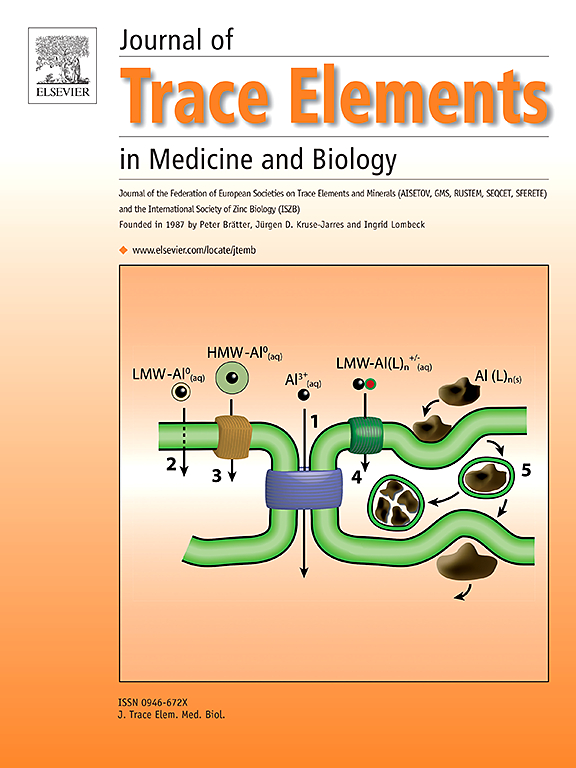Occurrence and health risk assessment of selected metals in commercially available infant formulas in Jordan
IF 3.6
3区 医学
Q2 BIOCHEMISTRY & MOLECULAR BIOLOGY
Journal of Trace Elements in Medicine and Biology
Pub Date : 2025-02-01
DOI:10.1016/j.jtemb.2024.127585
引用次数: 0
Abstract
Background
Infant formulas are the primary source of nutrition for infants and babies when breastfeeding is unavailable, as they are enriched with a variety of macro- and micronutrients to improve their nutritional value and satisfy the different needs of babies. Recently, there has been a rising concern about toxic metal levels in infant formulas, as highlighted by various studies. However, there are currently no sufficient studies focusing on toxic metal levels of infant formulas in Jordan. The current study aims to determine the levels of 25 metals, including Na, Mg, K, Ca, Cr, Fe, Mn, Co, Ni, Cu, Zn, Li, Ti, V, Ga, Sr, Ag, Ba, Bi, Th, U, Al, Cd, In, and Pb, in infant formulas (starter infant formula, follow-on formula, and growing-up formula) using inductively coupled plasma mass spectrometry (ICP-MS) and evaluate their safety and quality.
Methods
The metal compositions of 37 infant formula samples collected from different Jordanian pharmacies were determined using inductively coupled plasma-mass spectrometry (ICP-MS) after digesting the samples with 9 mL of HNO3 (70 %) and 3 mL of H2O2 (30 %) using the microwave-assisted digestion technique. The possible health risks associated with the exposure to Cd, Pb, Al, and Ni in infant formulas were evaluated using estimated daily intake, target hazard quotient, and hazard index calculations. Also, method validation, including accuracy, precision, limit of detection, and limit of quantification, was performed.
Results
The results revealed that follow-on formula (intended for 7–12-month-old babies) had the highest mean concentration of all studied metals, except for zinc, which had the highest mean concentration in starter infant formula (intended for less than 6-month-old babies). Also, 72.97 % and 89.20 % of the tested samples had Pb and Cd levels that exceeded the European permissible limit, respectively. Regarding the estimated daily intake (EDI), babies aged 7–12 months were found to be the most exposed to Cd and Pb toxicity, while babies aged less than 6 months were found to be the most exposed to Ni toxicity. Unfortunately, the overall non-carcinogenic negative adverse effects (hazard index HI) of Cd and Pb for babies aged 7–12 months exceeded the acceptable threshold of 1.
Conclusion
Based on the results, the consumption of infant formulas sold in Jordan may pose serious health risks to babies, with Cd and Pb levels in follow-on formulas (posing the highest risk). The source of contamination in infant formulas may be contaminated raw materials, the manufacturing process, packaging, or storage. So, strict regulations ought to be established to safeguard the health of babies.
约旦市售婴儿配方奶粉中某些金属的存在和健康风险评估。
背景:婴儿配方奶粉是婴幼儿不可母乳喂养时的主要营养来源,因为配方奶粉富含多种宏量和微量营养素,可提高其营养价值,满足婴儿的不同需求。最近,人们越来越关注婴儿配方奶粉中的有毒金属含量,各种研究都强调了这一点。然而,目前还没有针对约旦婴儿配方奶粉中有毒金属含量的充分研究。本研究旨在利用电感耦合等离子体质谱法(ICP-MS)测定婴儿配方奶粉(幼儿配方奶粉、后续配方奶粉和成长配方奶粉)中Na、Mg、K、Ca、Cr、Fe、Mn、Co、Ni、Cu、Zn、Li、Ti、V、Ga、Sr、Ag、Ba、Bi、Th、U、Al、Cd、In和Pb等25种金属的含量,并对其安全性和质量进行评价。方法:采用微波消解技术,分别用9 mL HNO3(70 %)和3 mL H2O2(30 %)消解37份来自约旦不同药店的婴儿配方奶粉样品,采用电感耦合等离子体质谱法(ICP-MS)测定样品的金属成分。通过估计每日摄入量、目标危害商和危害指数计算,评估与婴儿配方奶粉中Cd、Pb、Al和Ni暴露相关的可能健康风险。方法验证,包括准确性、精密度、检出限和定量限。结果:结果显示,后续配方(适用于7-12个月的婴儿)除锌外,所有研究金属的平均浓度最高,锌在初级婴儿配方(适用于6个月以下的婴儿)中具有最高的平均浓度。此外,72.97% %和89.20% %的检测样本的铅和镉含量分别超过欧洲允许限量。在估计每日摄入量(EDI)方面,发现7-12 个月的婴儿最容易受到Cd和Pb毒性的影响,而6个月以下的婴儿最容易受到Ni毒性的影响。不幸的是,Cd和Pb对7-12月龄婴儿的总体非致癌负面影响(危害指数HI)超过了可接受的阈值1。结论:根据结果,在约旦销售的婴儿配方奶粉的消费可能对婴儿构成严重的健康风险,后续配方奶粉中的Cd和Pb水平(构成最高风险)。婴儿配方奶粉的污染源可能是受污染的原料、生产过程、包装或储存。因此,应该建立严格的规定来保护婴儿的健康。
本文章由计算机程序翻译,如有差异,请以英文原文为准。
求助全文
约1分钟内获得全文
求助全文
来源期刊
CiteScore
6.60
自引率
2.90%
发文量
202
审稿时长
85 days
期刊介绍:
The journal provides the reader with a thorough description of theoretical and applied aspects of trace elements in medicine and biology and is devoted to the advancement of scientific knowledge about trace elements and trace element species. Trace elements play essential roles in the maintenance of physiological processes. During the last decades there has been a great deal of scientific investigation about the function and binding of trace elements. The Journal of Trace Elements in Medicine and Biology focuses on the description and dissemination of scientific results concerning the role of trace elements with respect to their mode of action in health and disease and nutritional importance. Progress in the knowledge of the biological role of trace elements depends, however, on advances in trace elements chemistry. Thus the Journal of Trace Elements in Medicine and Biology will include only those papers that base their results on proven analytical methods.
Also, we only publish those articles in which the quality assurance regarding the execution of experiments and achievement of results is guaranteed.

 求助内容:
求助内容: 应助结果提醒方式:
应助结果提醒方式:


